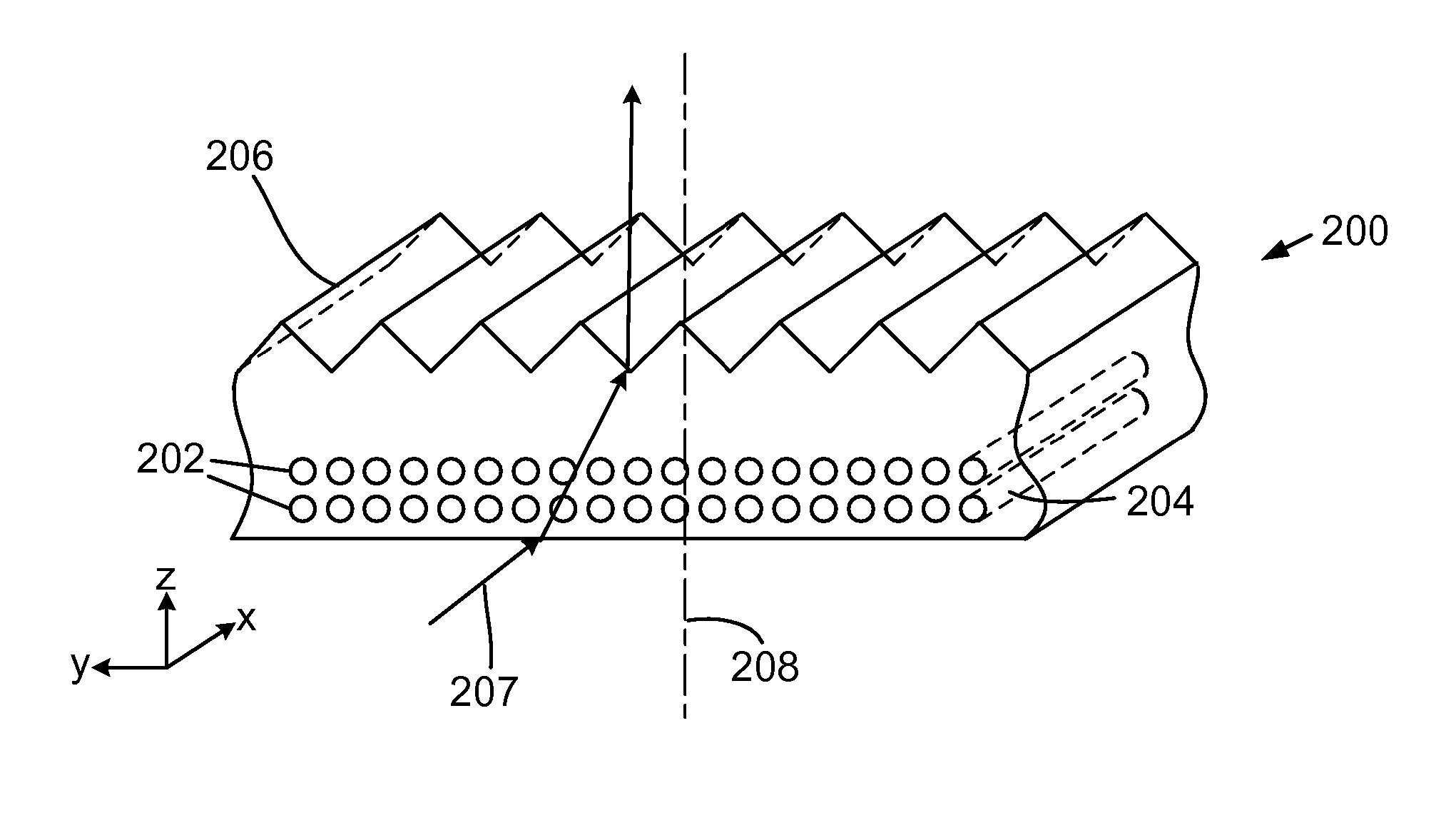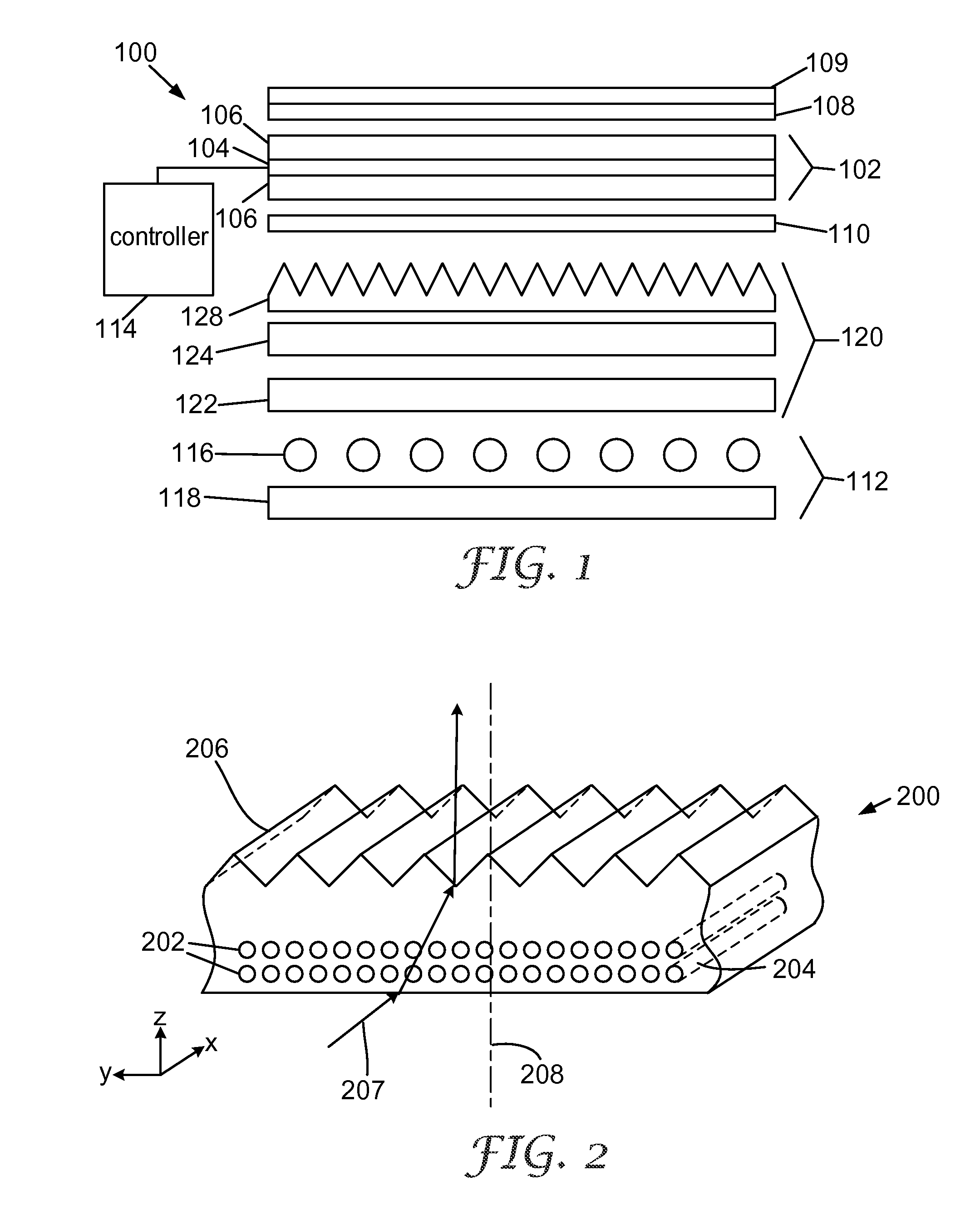Structured Composite Optical Films
- Summary
- Abstract
- Description
- Claims
- Application Information
AI Technical Summary
Benefits of technology
Problems solved by technology
Method used
Image
Examples
example 1
Monolithic Brightness Enhancing Composite Layer
[0081] The raw materials used for the polymer resin in this example were:
ComponentWt. %C169.3C229.7C31.0
[0082] The fiber reinforcement was a Hexcel Style 106 woven fiber fabric with a CS767 finish. The refractive index of the fibers is 1.551±0.002. The refractive index of the cured composite resin mixture used here and in all of the following examples (69.3 / 29.7 / 1.0 Ebecryl 600 / TMPTA / Darocur 1173) is 1.5517. Therefore, the refractive index difference between the polymer matrix and the fiber is around 0.0007.
[0083] The preparation of the monolithic composite started by taping a 12″×24″ (30 cm×60 cm) sheet of PET to the leading edge of a 12″×20″×¼″ (30.5 cm×50.8 cm×0.6 cm) sheet of aluminum. A molding tool for producing a prismatic brightness enhancing structure was laid on top of the PET and a sheet of fiberglass fabric was laid on top the molding tool. The molding tool was designed to produce an undulating prismatic brightness enhan...
example 2
Monolithic Brightness Enhancing Composite Film on Reflecting Polarizer
[0087] A monolithic composite like described in Example 1 was formed on the surface of a primed multilayer reflective polarizer (RP) similar to 3M Vikuiti™ DBEF-P2. A second composite layer having flat sides was placed on the other side of the polarizer layer for mechanical support. In this example, a laminating adhesive was used to join the polarizer layer to the composite layers. Thus, the final structure had the following layers, from top to bottom: transparent composite with prismatic surface / laminating adhesive / RP / laminating adhesive / transparent composite. This structure was similar to that depicted in FIG. 7.
[0088] The laminating resin was formed as follows:
ComponentWt. %C464.4C524.7C69.9C71.0
[0089] A primer was used to improve the adhesion of the acrylate resin to both sides of the RP layer. The primer was a mixture of hexanediol diacrylate 97% (w / w) and benzophenone 3% (w / w). For priming sheets of film...
example 3
Monolithic Composite with Diffractive Surface
[0095] A transparent fiberglass composite was formed with a diffractive microstructured surface on a polyimide molding tool. The article thus comprises a single composite layer with a diffractive structured surface. The sample was prepared in the same manner as described above for Example 1, except that the molding tool provided a diffractive structure on the layer. Also, a release coating was applied to the molding tool prior to the first use to aid the removal of the cured composite from the molding tool.
[0096] The diffraction pattern was square zone plate with one millimeter squares, seventeen zones and sixteen levels, designed to work at 632 nm, with a focal length of 1 cm. A partial cross-section of the photopolymerized “positive image” is schematically represented in FIG. 8. The figure shows three of the seventeen zones, a central zone 802 and two side zones 804. The maximum height, h, of each zone reached to 632 nm. The diffracti...
PUM
 Login to View More
Login to View More Abstract
Description
Claims
Application Information
 Login to View More
Login to View More - R&D
- Intellectual Property
- Life Sciences
- Materials
- Tech Scout
- Unparalleled Data Quality
- Higher Quality Content
- 60% Fewer Hallucinations
Browse by: Latest US Patents, China's latest patents, Technical Efficacy Thesaurus, Application Domain, Technology Topic, Popular Technical Reports.
© 2025 PatSnap. All rights reserved.Legal|Privacy policy|Modern Slavery Act Transparency Statement|Sitemap|About US| Contact US: help@patsnap.com



